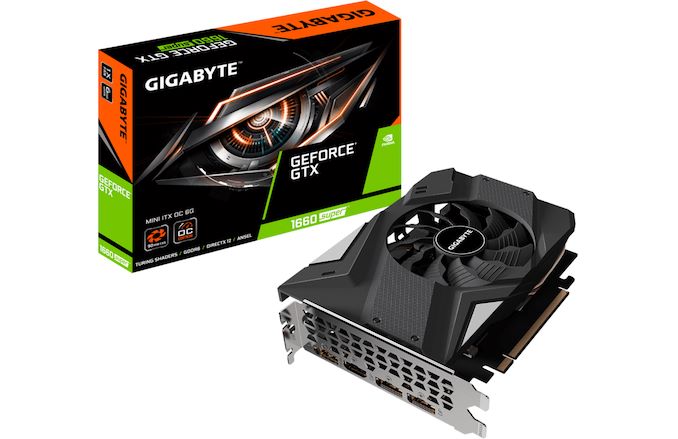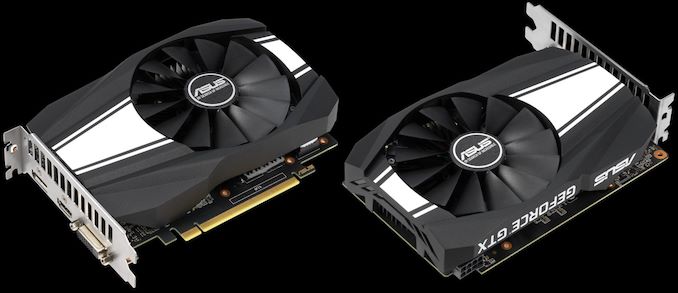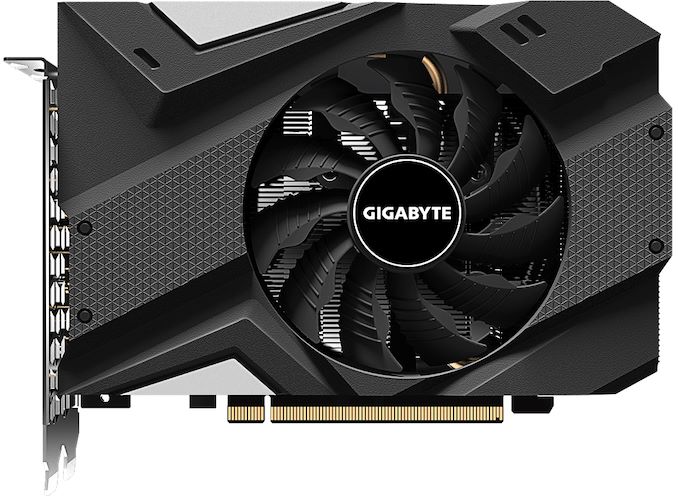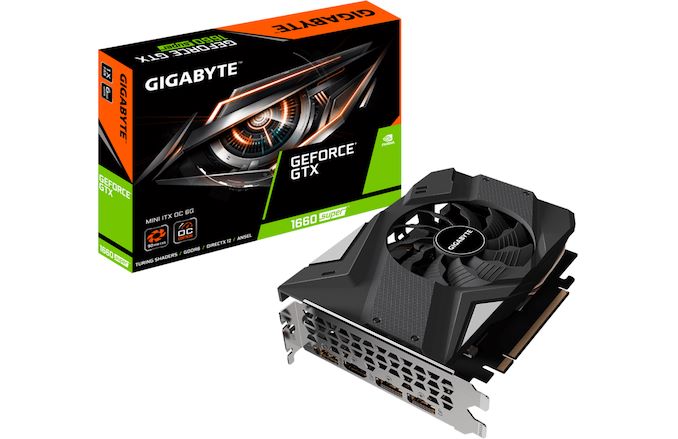ASUS & GIGABYTE Prep Mini-ITX GeForce GTX 1660 Super Cards
by Anton Shilov on November 6, 2019 4:00 PM EST
Last week NVIDIA introduced its latest GeForce GTX 1660 Super performance mainstream GPU. There are plenty of designs to chose from, and both ASUS and GIGABYTE are now set to offer small form factor designs.
ASUS has two new GeForce GTX 1660 Super boards that are 17.4 centimeters (6.9 inches) long. The ASUS Phoenix PH-GTX1660S-6G and Phoenix PH-GTX1660S-O6G cards are based on NVIDIA’s TU116 GPU with 1408 CUDA cores, carry 6 GB of GDDR6 memory, share the same PCB design with one 8-pin auxiliary PCIe power connector, feature three display outputs (DVI-D, DP 1.4, HDMI 2.0b), and use the same dual-slot cooling system with one dual ball bearing fan. The only difference between the two are their clocks and even they are pretty close: up to 1815 MHz vs 1830 MHz in OC mode.
GIGABYTE has a more 'canonical' GeForce GTX 1660 Super Mini ITX OC 6G (GV-N166SIXOC-6GD) board that is exactly 17 centimeters long. The card has NVIDIA’s TU116 GPU clocked at up to 1800 MHz, 6 GB of 14 Gpbs GDDR6 RAM, uses a dual-slot single-fan cooler with a heat pipe that can stop the fan in idle mode, has an 8-pin PCIe power connector, and offers four display outputs (DP 1.4, HDMI 2.0b).
| NVIDIA GeForce GTX 1660 Super Graphics Cards for Mini-ITX | ||||||
| NVIDIA Reference |
ASUS Phoenix PH-GTX1660S-6G |
ASUS Phoenix PH-GTX1660S-O6G |
GIGABYTE GV-N166SIXOC-6GD |
|||
| CUDA Cores | 1408 | |||||
| ROPs | 48 | |||||
| Core Clock | 1530 MHz | 1530 MHz (?) | ||||
| Boost Clock | 1785 MHz | 1815 MHz | 1830 MHz | 1800 MHz | ||
| Memory Clock | 14 Gbps GDDR6 | |||||
| Memory Bus Width | 192-bit | |||||
| VRAM | 6 GB | |||||
| Single Precision Perf. | 5 TFLOPS | ~5 TFLOPS | ||||
| Display Outputs | 1×DVI-D 1×DP 1.4 1×HDMI 2.0b |
1×DVI-D 1×DP 1.4 1×HDMI 2.0b |
3×DP 1.4 1×HDMI 2.0b |
|||
| TGP | 125W | ? | ? | ? | ||
| GPU | TU116 (284 mm2) |
|||||
| Transistor Count | 6.6B | |||||
| Architecture | Turing | |||||
| Manufacturing Process | TSMC 12nm "FFN" | |||||
| Launch Date | 10/29/2019 | Q4 2019 | ||||
| Launch Price | $229 | ? | ? | ? | ||
All three graphics cards are listed at ASUS’ and GIGABYTE’s websites, so expect them to be available shortly. Pricing wise, they should not be much more expensive than NVIDIA’s $229 MSRP for the GeForce GTX 1660 Super.













30 Comments
View All Comments
The_Assimilator - Wednesday, November 6, 2019 - link
Every time a manufacturer includes a DVI connector on a current-generation board design, God kills a kitten.Please Asus, think of the kittens.
Korguz - Wednesday, November 6, 2019 - link
dvi is a lot more useful, then the vga port new monitors still come with..eek2121 - Wednesday, November 6, 2019 - link
Only budget monitors include VGA ports. My 4k IPS monitor has one, neither did my previous 2 1440p monitors.timecop1818 - Wednesday, November 6, 2019 - link
I've never seen VGA on anything in the last ~10 years. What kinda garbage monitors are you buying?Korguz - Wednesday, November 6, 2019 - link
eek2121/timecop1818 various, from the 200 buck ones.. all the way up to 700, and some times higher then that. eek2121, 4k ips is considered budget ??? dangSamus - Wednesday, November 6, 2019 - link
Almost all business, corporate, and enterprise monitors in the $100-$250 ballpark have DSUB. Granted, most if not all of them have DVI, HDMI and\or DP.As do many projectors (current and legacy) and legacy televisions, particularly plasmas.
As if that weren't enough to keep the DVI and legacy analog VGA\DSUB connection around, it's important to point out CRT-based gaming has had a resurgence, granted you can find a Sony GDM FW910 or similar 1080P CRT. And these are obviously best suited for analog input as any digital input can introduce processing lag.
There is absolutely NOTHING wrong with including a DVI port. A DSUB port might be pushing the limits of logic (as a DVI-I can be simply converted to DSUB.)
DigitalFreak - Thursday, November 7, 2019 - link
There is absolutely no reason to have either VGA or DVI ports on a video card or motherboard. Both DP and HDMI ports can output to VGA and DVI using a dongle.29a - Thursday, November 7, 2019 - link
Dongles are a pain in the ass and they don't always work well, I deal with them everyday. A lot of business laptops have VGA because it just works and its everywhere.Eletriarnation - Thursday, November 7, 2019 - link
Not only that, but this is DVI-D so you can't get VGA out of it anyway. Why not save space with an DP++ port that has the same capabilities and more?DanNeely - Thursday, November 7, 2019 - link
They're all DVI-D because AMD and NVidia have phased out VGA support from their GPUs themselves. To put a VGA (or DVI-I) on a modern card the manufacturer would need to embed a DP-VGA adapter onto the board itself.